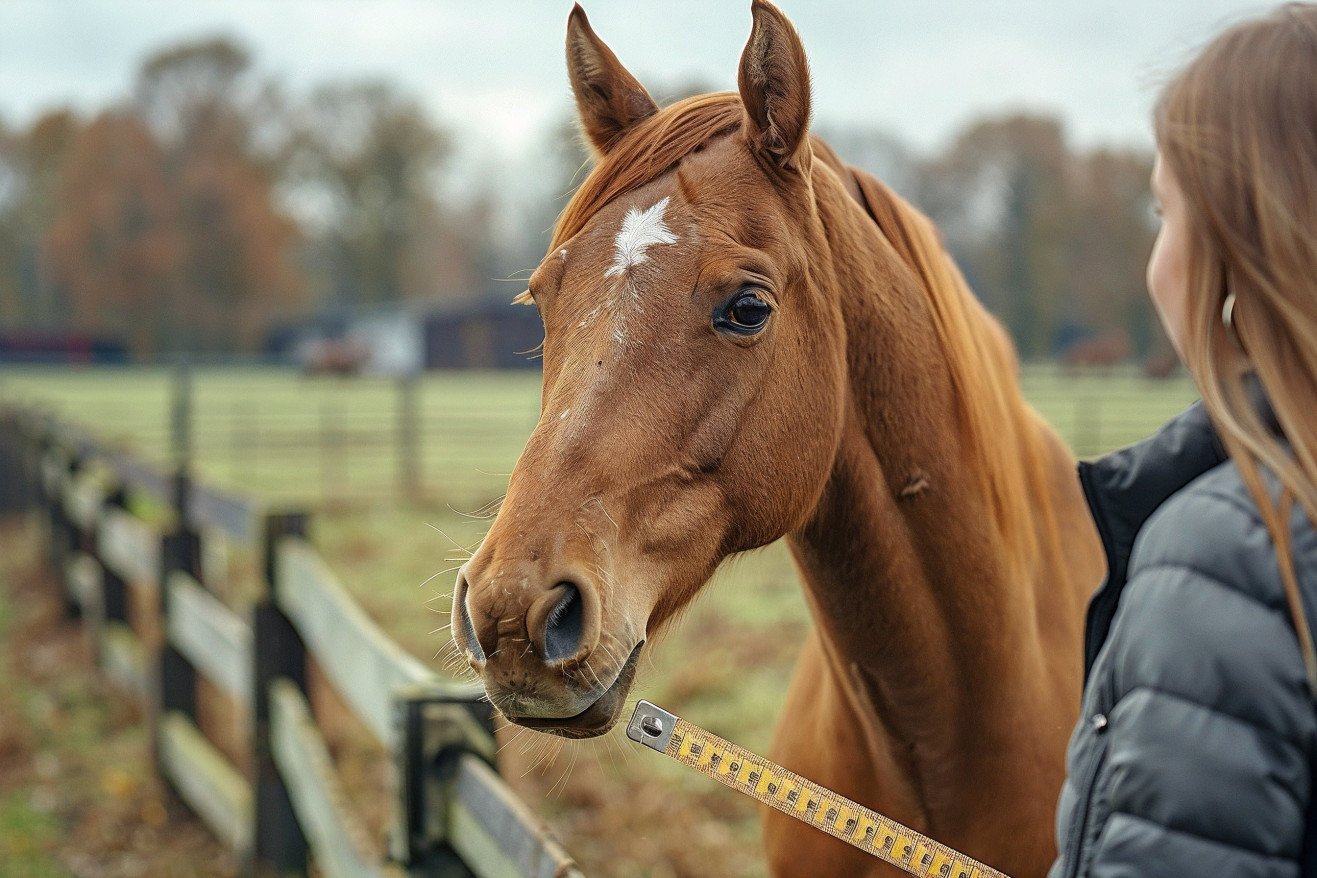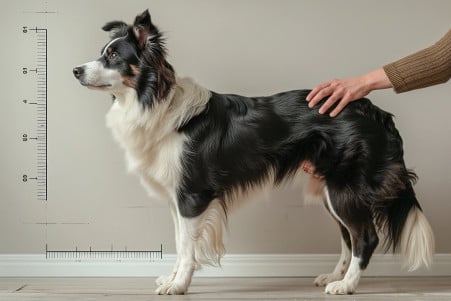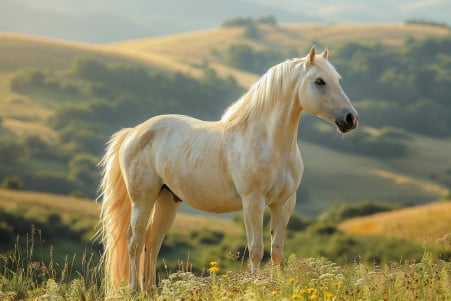How to Measure a Horse: A Complete Guide to Height and Weight
14 March 2024 • Updated 14 March 2024

Measuring a horse is an important yet unusual task, but it’s necessary for a horse’s health and care. To measure a horse’s height, stand a measuring stick at the withers, which is the highest point of the horse’s shoulder blades.
The height is then recorded in ‘hands,’ where one hand is equal to 4 inches. To measure a horse’s weight, it’s best to use a weight tape specifically designed for horses or an equine scale.
This article will cover how research in veterinary science, equine management, and technology has led to the exact methods used to measure horses. By looking at scholarly research, industry standards, and technological breakthroughs, this article will help ensure that you understand not just the ‘how’ but the ‘why’ behind each part of the measuring process, so you can measure your horse with confidence.
What are the important ways to measure the size of a horse?
Understanding Horse Conformation for More Accurate Measurements
Horse conformation, the arrangement of body parts in relation to one another, is one of the most important factors in horse evaluation and impacts a horse’s ability to perform in a variety of disciplines. EquiMed notes that conformation is the evaluation of how well a horse’s structure—muscle, balance, and bone alignment—fits the horse’s intended use, whether that be racing, jumping, or trail riding.
Conformation evaluation includes the assessment of balance, muscle, structural correctness, and breed type. Balance is the way that the horse’s body parts fit together, and according to MU Extension, it’s important for both agility and strength. Muscle, according to UGA Cooperative Extension, is evaluated based on both the amount and the way that it’s distributed, both of which impact a horse’s ability to move and perform.
Conformation is directly related to horse health, and it can impact a horse’s ability to stay sound and healthy throughout its life. It can also impact the accuracy of measurements. For example, a horse with a structural fault like high withers may be measured as taller than it actually is, while a horse with a lot of muscle may be weighed as heavier than it is.
The impact of conformation on measurements can be seen in a variety of equine sports. For example, a cutting horse needs to have good structural correctness to be able to make quick turns, while endurance horses need to have lighter muscle mass, which can impact weight measurements.
As a result, horse care and management need to use different measurement methods to account for the differences in horse conformation to ensure that measurements are accurate and consistent. This focus on individualized care is an example of how conformation can be used in the real world to impact the way that horses are measured.
How to Measure Horse Height and Weight
Knowing a horse’s size is important for its well-being, and the hand has long been the standard unit of measurement for equine height. A hand is 4 inches long, and the unit goes back to the ancient Egyptians, according to Pink Equine.
There are many tools that can be used to accurately measure a horse’s height. The most reliable include height measuring sticks that are marked with hand measurements and tapes that are specifically designed for equine measurements.
For a more DIY option, a plumb line, which is explained in many house painting how-tos, can be used to double-check a horse’s height.
For weight, Just Horse Riders says that scales are the most accurate, with weight tapes being the next best option. However, both need to be used properly to ensure accurate results, which are important for everything from monitoring the animal’s health to calculating medication doses.
Globally, the metric system is used, and one hand is equal to approximately 10.16 cm, which makes it easier to understand measurements from other countries. This is especially important when sharing information or if you’re competing in a sport that has global standards.
Once you have accurate measurements, you can use them to take advantage of the latest technology that’s available to horse owners.
The Future of Horse Measurement: Wearable Sensors and More
The future of horse measurement is likely to be shaped by the continued development of wearable sensors and other digital technologies.
The use of wearable sensors in horse measurement is likely to continue to grow. In particular, the use of inertial measurement units (IMUs) is likely to expand. A paper in PMC explains that IMUs are essential for objective gait analysis because they can provide accurate measurements of a horse’s movement in real-world conditions.
IMUs are wearable sensors that measure acceleration forces and angular velocities in three dimensions, and they can be used to provide a detailed analysis of equine locomotion, including the identification of even mild lameness.
In addition to IMUs, wearable sensors that use computer vision are likely to become more common. For example, a study in Frontiers in Veterinary Science notes that researchers are increasingly using computer vision to develop wearable sensors that can be used to detect diseases in horses before they become symptomatic. This is important because early disease detection is essential for ensuring the welfare of horses.
Beyond the Tape Measure: Exploring Additional Digital Tools
In addition to wearable sensors, other digital technologies are likely to play a role in the future of horse measurement. For example, a report by Alltech explains that 3D printing and artificial intelligence are already being used to improve equine care.
For example, 3D printing is being used to create custom-fitted horseshoes, while artificial intelligence is being used to improve the analysis of data collected from horses, which in turn is improving decision-making in the areas of training and health care.
The use of wearable sensors and other digital technologies in horse measurement is likely to improve the precision, accuracy, and effectiveness of horse measurement.
However, there are also challenges that need to be addressed, including the need to ensure the reliability of wearable sensors in a range of environments.
The need to ensure that research on wearable sensors and other digital technologies is translated into practical applications is also important. In the future, the potential integration of wearable sensors and other digital technologies with the Internet of Things (IoT) is likely to lead to a more connected and comprehensive approach to horse measurement.
A History of the Hand: How Horses Have Been Measured Over the Years
The ancient Egyptians are credited with starting the long tradition of using the hand as a unit of measure for horses when they used the royal cubit. This cubit was divided into palms or hands, a system that was also used in the measurements of Ancient Israel, Greece, and Rome, according to Horse & Hound. In medieval Europe, King Henry VIII made the hand exactly four inches in 1541, and this measurement is still used today.
The tradition of measuring horses in hands was further solidified when the English Jockey Club adopted the hand as an official unit in 1793. The use of hands to measure horses has continued not only because of its history but also because of its importance in the equestrian world.
According to The Equestrian, the hand system allows for a level of detail in measuring horses that is necessary for the wide variety of equestrian sports that have been practiced for centuries.
Today, even though the metric system is used around the world, the equestrian world has kept the tradition of measuring horses in hands alive, and the hand has become an important part of the equestrian infrastructure, symbolizing both history and practicality. The continued use of this ancient method of measurement shows how simple and important it is and asks us to think about how tradition and accuracy can be balanced in the modern world.
Understanding the Complexities of Equine Measurement
The search for accuracy in equine measurement is riddled with challenges. A study published in PubMed found that measurement errors, including inconsistencies in the use of tools and differences in the position of the horse’s head, led to large variations in the measurements taken. The addition of a second level to the traditional measuring stick led to a 57% improvement in accuracy, highlighting the need for a consistent and standardized approach.
Environmental factors also come into play; the same study found that horses’ measurements changed as they acclimated to their environment and when they were sedated. This shows the importance of keeping the environment as consistent as possible when measuring horses to minimize variation.
To ensure measurements are as accurate as possible, it’s important to follow best practices, including allowing time for the horse to acclimate and using standardized tools and methods.
A study published in Animals found that the type of weigh tape used can affect the measurements taken, suggesting that breed-specific tapes may be more accurate. This is important because, as the study points out, consistently underestimating the weight of larger horses can have real-world implications, including leading to incorrect dosages of medications, as shown in the study linked above on Anthelmintic treatment and Antimicrobial use in horses.
In addition, the most important factor is the experience and training of the person taking the measurements. Accuracy improves with experience and an understanding of the potential factors that can impact the results. To ensure measurements are accurate, it’s important to not only use the right tools but to also have an understanding of the animal and the environment in which the measurements are being taken.
Final Thoughts: The Importance of Accurate Horse Measurement
The art and science of horse measurement play a critical role in ensuring a horse’s health and proper care. This article has highlighted the importance of accurate measurement and emphasized the role of traditional methods like the use of a height measuring stick in “hands”, weight tapes, and equine scales in determining a horse’s weight. When used properly, these tools provide horse owners, trainers, and veterinarians with important information.
From inertial measurement units to artificial intelligence, we’ve shown how technology is changing the way we measure and care for horses. However, it’s the combination of these new technologies with traditional methods that have shaped the current state of horse measurement and demonstrate the history of horse care.
Understanding the impact of factors like environmental conditions and horse conformation on the accuracy of measurements is essential to minimizing errors. In the future, research and technological advances will continue to improve horse measurement, benefiting the health of horses and the equestrian activities we love. The history of measurement is a reflection of our ongoing dedication to horse health and care.


